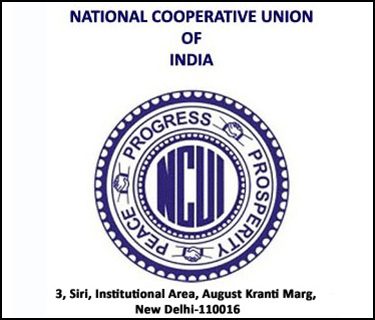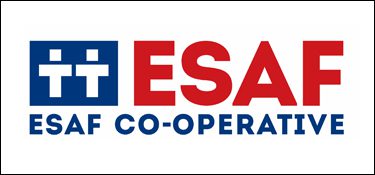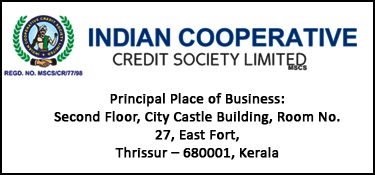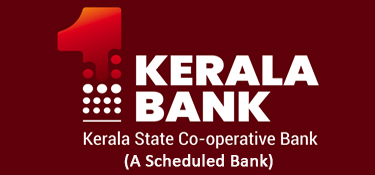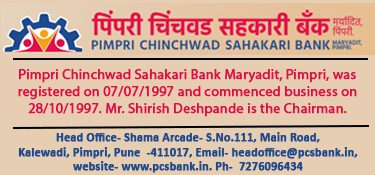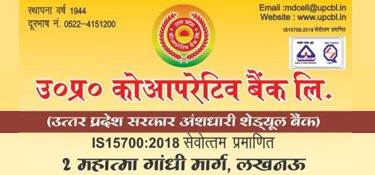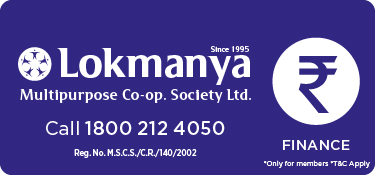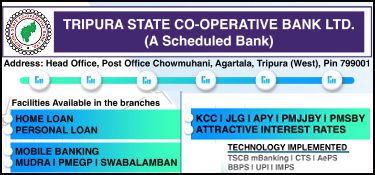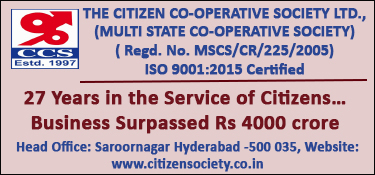The Notification issued by RBI on June 5, 2014 that the balances kept by DCCBs with SCBs as also term deposits with public sector banks will be eligible for being reckoned for SLR purpose upto March 31, 2015 and will not be eligible for being reckoned for SLR purpose w.e.f. April 1, 2015 is considered as a death knell to SCBs and DCCBs.
The apex body of state cooperative banks NAFSCOB has written a letter to RBI governor Dr. Raghuram Rajan on the issue the Banking Laws (Amendment) Act 2012 – Amendments to Section 18 & 24 of Banking Regulation (B.R.) Act, 1949 (AACS).
On June 5 the RBI decided to increase the CRR for non-Scheduled SCBs and all DCCBs from 3.00 per cent to 4.00 per cent of their total net demand and time liabilities without payment of interest on par with Scheduled SCBs w.e.f. the fortnight beginning July 12, 2014.
The MD writes “Though there will be additional burden on the non-Scheduled SCBs and all DCCBs – a matter of concern to many DCCBs due to increase in CRR level, the increase may not really affect their bottom line to a greater extent for the time being. However, any increase in future to keep at par with Commercial Banks without payment of interest will create problems for these Banks as they do not have adequate resources to cope with the changes from time to time.”
Nafscob MD further says “you may kindly agree with us that keeping into consideration the peculiar functioning of these banks in the restricted areas, the Banking Regulation Act, 1949 itself specifically allowed them to maintain CRR at the minimum statutory level of 3.00 per cent. We sincerely hope that you appreciate the genuine issue involved in this regard and consider payment of interest on CRR balances.”
Bhima Subramaniyam, Nafscob MD however, welcomed the decision of RBI to reduce the SLR for all SCBs and DCCBs by 250 basis points from 25.00 per cent to 22.50 per cent of their total net demand and time liabilities with effect from the fortnight of beginning July 12, 2014. The decision helps to have more liquidity with both SCBs and DCCBs.
The SCBs and DCCBs not maintaining SLR in the form and manner specified are given time upto 31-03-2015 to comply with instructions contained in the said Notification.
In the detailed letter Nafscob argues that the directives of RBI that the balances kept by DCCBs with SCBs as also term deposits with public sector banks will not be eligible for being reckoned for SLR purpose w.e.f. April 1, 2015, has far reaching implications and put both Scheduled and Non-Scheduled SCBs and all the DCCBs into serious financial constraints and other fall outs which are as under:
i) As on 31.03.2013, the aggregate deposits of the DCCBs stood at Rs.1,95,122.40 Crores. As against these deposits, the CCBs were maintaining SLR to the tune of Rs.48,780.60 Crores. With an average growth rate of 10%, the figures should have been increased to Rs.2,14,634.64 Crores and Rs.53,658.66 Crores being 25% of the NDTL. Now that, the SLR is reduced from 25% to 22.50% w.e.f. July 12, 2014, the requirement of maintenance of SLR would be reduced to Rs.48,292.79 Crores. As per the directives of Reserve Bank of India, this amount will be invested in approved securities as defined under Section 5(a) of the Banking Regulation Act, 1949 read with Section 56 thereof by 31.03.2015 as the unencumbered term deposits maintained by a DCCBs with the SCB of the State concerned shall not be reckoned towards SLR from April 01, 2015. This means, the deposits of the SCBs will be eroded to that extent within a stipulated time frame of around Nine (9) months. Neither the RBI nor NABARD issued guidelines or suggested implementable strategies as to how the SCBs would be able to arrange such a huge amount within this stipulated time frame as the same have been locked in either in loans and advances or in other investments. This is also very important to assess more particularly the process of recapitalization support which is either incomplete or yet to be initiated.
ii) As the SCBs are the leaders of the Short Term Cooperative Credit Structure (STCCS) of the States, they have been arranging funds for the DCCBs and PACS to cater to the credit requirement of the farm families both for short term crop loans and medium term agricultural loans. They have also been supporting infrastructure and technology related endeavours of their affiliated DCCBs by utilizing the deposit resources available with them. Presently all DCCBs are maintaining SLR and non-SLR investments with SCBs as the SCB is a balancing center for all DCCBs and sole refinance agency to the DCCBs. As a balancing Centre for the funds of the DCCBs, SCBs are functioning in such a manner that the requirements of all the DCCBs are met by the SCBs without causing difficulty to them. The diversion of the investments from the SCBs to other avenues of investments in securities will result in outflow of huge funds from the SCBs and the liquidity position of SCBs will adversely affect. Further, if the directives of RBI are implemented the SCBs cannot meet any credit requirements of the DCCBs in case of urgency due to the tight liquidity position of the Apex Bank. Further, the SCBs cannot afford such a sudden outflow of funds arising out of the directives issued by RBI. The outflow of funds will adversely disturb the loaning pattern to DCCBs as existing in the SCBs. The involvement in the SAO loans at the present levels cannot be continued and it needs to be restricted to the quantum of refinance allowed by the NABARD. Thus SCBs cannot involve their funds in SAO loans to DCCBs. Infact, bridging the gap of the requirement of credit and NABARD refinance cannot be done under such a deliberately created adverse circumstances. The deposit position of SCBs will come down substantially on withdrawal of funds by DCCBs to implement the directives of RBI. As the deposits are maintained with SCBs the additional financial accommodation for the DCCBs is on higher side on various immediate financial requirements, when compared to the Government securities and the returns are reasonably high on the investments of the DCCBs with SCBs. It may also pave way to DCCBs to divert its Non-SLR funds from SCBs other investment avenues, while availing all types of refinances from SCBs. This ultimately leads to the DCCBs to avail the finances at a very higher rate adding to the cost of management more than the meager earnings on the deposits invested with other financial institutions than SCBs.
iii) The non-Scheduled SCBs and DCCBs have been getting almost fixed returns from the SLR investment made with the SCBs at a rate not lower than 9%. The investment in Government Securities may not yield more than 8% and, therefore, the profitability of the DCCBs would be reduced and they may not be able to comply with the statutory requirements envisaged in the Banking Regulation Act, 1949 (AACS).
iv) The CCBs were in a comfortable position by placing their SLR requirements with the SCBs with an assured return. It may be pertinent to record that non-Scheduled SCBs and DCCBs do not have expertise in investment in Government Securities (G-sec). The Governments Securities are subject to market risks and therefore the banks may incur loss in the event the Government Securities rates are going down. It will be detrimental to their financial health to go for investment in Government Securities and staff of DCCBs needs to be adequately trained in this regard. The investment in approved Securities is a technical skill, which is yet to be available among the employees of the DCCBs. Acquiring this type of skill within a stipulated time frame of 9 months is a remote possibility and there would be serious dislocation in management of funds by the DCCBs. There is every possibility, under such circumstances, they may be driven into the hands of brokers to be “exploited” instead of ‘guided’.
v) In case of investment in approved Securities, the return on the investment is subjected to deduction of Income Tax at source. Seeking refund of the Income Tax deducted at source also requires skill for the purpose among the employees of DCCBs, which will also create enormous problems for them. In the end, the banks would be subjected to litigations on this issue.
vi) Some of the SCBs provided credit accommodation to Cooperative Sugar Mills, Cash Credit Limits to ARDBs from out of the resources available with them and for which no refinance is available from NABARD. SCBs is also providing ST SAO limits to a great extent to DCCBs out of its own resources and also providing refinance for other purposes. It is a matter of serious concern that implementation of National Public Distribution System which is being operated through cooperative societies and other Government programmes relating to welfare of the farmers and rural population will get severely affected due to the shortage of funds at the level of SCBs. With the erosion of funds arising out of the directives of RBI it may not be possible for SCBs to meet the credit needs of DCCBs and consequently will have adverse impact on credit flow to different sectors as well as on profitability of the banks. Some of the SCBs pay more interest to the DCCBs on their Fixed Deposits kept for their SLR purpose as compared to the interest earned on Government Securities by the bank itself. Moreover, the SCBs provide various line of credit facilities to the DCCBs on cheaper rates. SCBs may be constrained to withdraw the present facilities extended to DCCBs due to the implementation of directives of RBI. The implementation of directives of RBI will certainly have adverse impact on the profitability of the DCCBs and also maintenance of CRAR requirements and consequently on sanction/availment credit limits from NABARD and on flow of credit in the States.
It is quite possible that the SCBs and DCCBs may not be able to place their resources in Government Securities because of non-availability of sufficient Government Securities.
Mr Subramainyam has a few suggestions:
1. In view of the forgoing, we request you kindly to withdraw the Notification dated June 5, 2014 issued by RBI directing that ‘the balances kept by DCCBs with SCBs as also term deposits with public sector banks will not be eligible for being reckoned for SLR purpose w.e.f. April 1, 2015’.
2. Further, we also request you kindly to consider that the directives relating to maintaining of SLR may be modified allowing the DCCBs to maintain their SLR in unencumbered deposits with the SCBs.
3. Alternatively and in case of any constraints to withdraw the above RBI Notification, we request you kindly to allow the balances kept with SCBs as term deposits by DCCBs to be reckoned for SLR purpose till April 1, 2020 or till the PACS and DCCBs are entirely recapitalized aimed at wiping out the accumulated losses and bring them back to take off stage.
4. With effect from April 1, 2020 DCCBs may be allowed to switch over from the existing system of maintenance of SLR with the SCBs of the State concerned to approved securities at a rate of 20% every year so that the strain on the resources of the SCBs can be tolerated by them.











